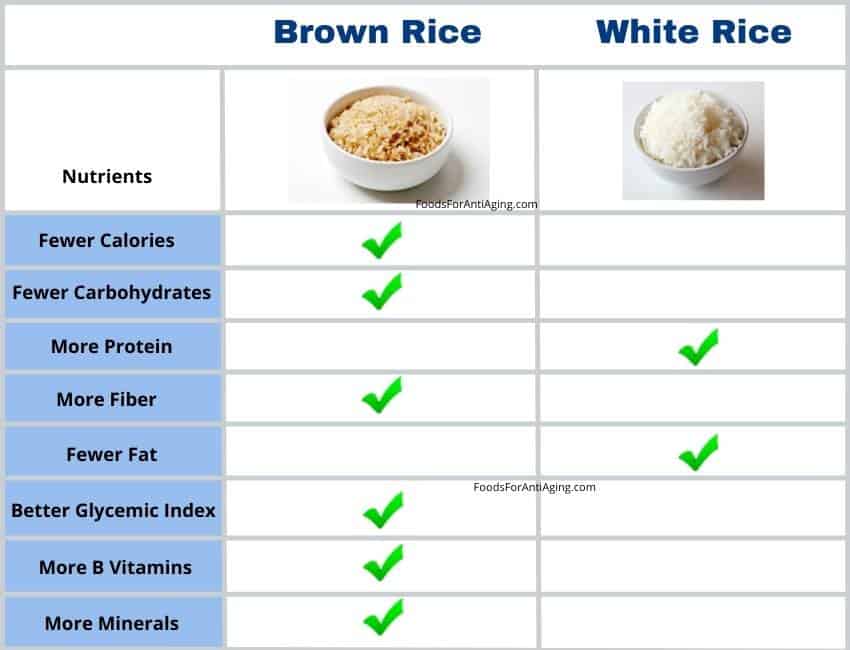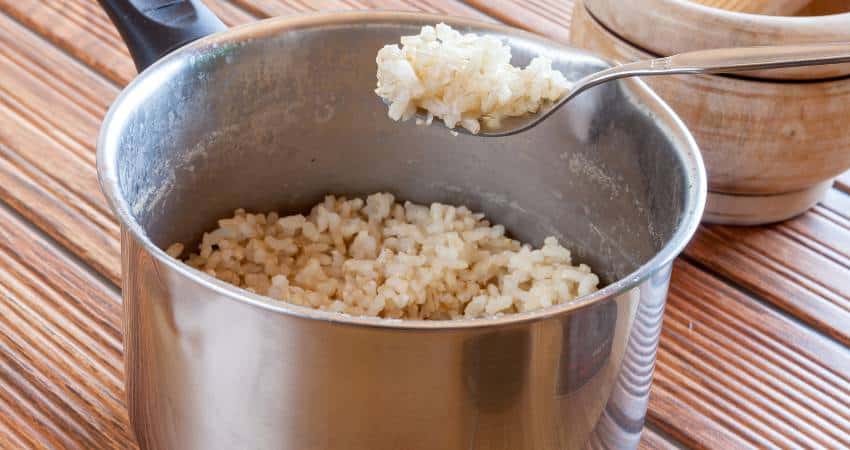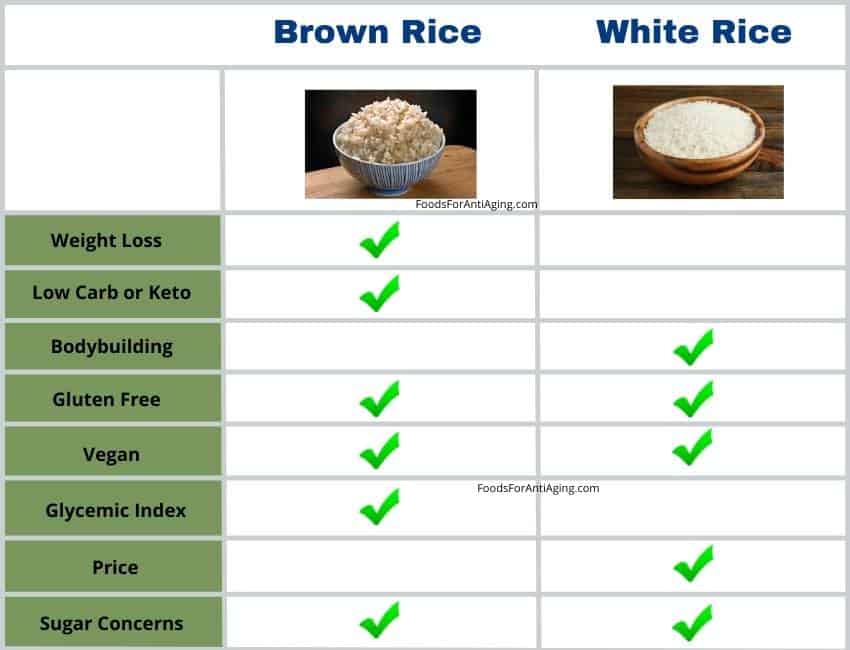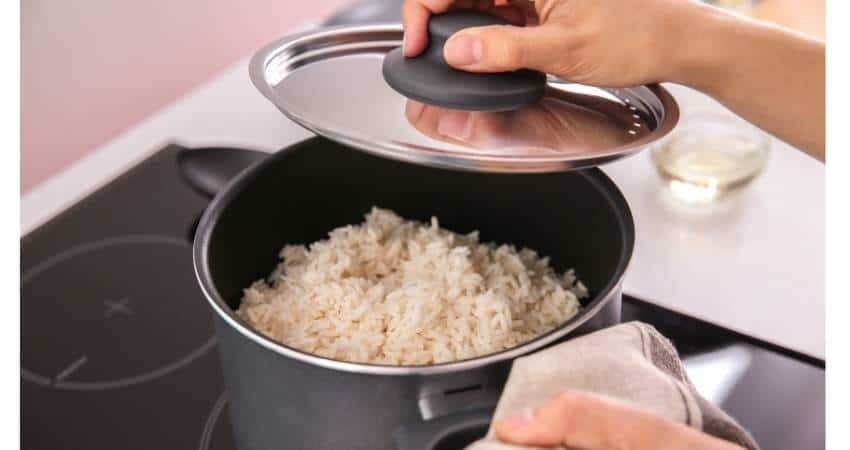Brown Rice vs White Rice: Which is Better? Let’s Compare
As a Certified Healthy Coach specializing in nutrition, I spend much time informing people about healthy foods. Brown rice vs white rice are two which I’m often asked about. Let’s answer the most common question asked, which one is better?
Brown rice is better than white rice due to its higher percentage of vitamins, minerals, fiber and antioxidants. It is better for weight loss due to its fewer calories and carbohydrates. Compared to white rice, it has a better glycemic index and is less processed.
This article will include a side-by-side nutrient comparison and determine which rice may be better based on the most common goals people have. In addition, I’ll examine their glycemic index, satiety index, tastes, prices, health benefits and if one can substitute for the other.
As a Certified Health Coach many people ask me about food comparisons including rice. I’ve purchased, researched, consumed and used both of these prior to, during and sometimes after writing this article.
The Differences Between Brown Rice and White Rice
Many people are familiar with rice but they may not know much about their differences other than the color. Therefore, let’s examine what the difference is between the two.
Brown rice is a whole grain containing all three parts including the bran, germ and endosperm. It is less processed and contains more nutrients. White rice is a grain only containing the endosperm after its bran and germ have been removed. It cooks faster and is softer than the chewier brown rice.
Some More Differences Between The Two Grains
- Brown rice has a better glycemic index.
- White rice costs 6% less.
- The white grain has a better satiety index than the brown grain.
- The brown grain has more vitamins and minerals.
- Brown rice has more fiber.
- Brown rice has fewer calories.
- Brown tastes earthier and has a harder texture than the softer white grain.
- The brown grain is a light brown color. The white variety is a white color.

Brown Rice vs White Rice: Nutrient Comparison
The following table is a side-by-side comparison of the nutrients contained in 100-grams of each one, medium grain and cooked.
| Brown Rice – Cooked (100 g) | White Rice – Cooked (100 g) | |
| Calories | 112 | 130 |
| Protein | 2.32 g | 2.38 g |
| Carbohydrates | 23.5 g | 28.6 g |
| Fiber | 1.8 g | 0.4 g |
| Fat | 0.83 g | 0.21 g |
| Sugar | 0.40 g | 0.05 g |
| Vitamin A | 0 IU | 0 IU |
| Beta-carotene | 0 mcg | 0 mcg |
| Vitamin C | 0 mg | 0 mg |
| Vitamin B6 | 0.15 mg | 0.05 mg |
| Vitamin B9 (Folate) | 4 mcg | 2 mcg |
| Vitamin B1 (Thiamin) | 0.10 mg | 0.02 mg |
| Vitamin B2 (Riboflavin) | 0.01 mg | 0.02mg |
| Vitamin B3 (Niacin) | 1.33 mg | 0.40 mg |
| Vitamin B5 (Pantothenic Acid) | 0.39 mg | 0.41 mg |
| Magnesium | 44 mg | 13 mg |
| Phosphorous | 77 mg | 37 mg |
| Potassium | 79 mg | 29 mg |
| Iron | 0.53 mg | 0.20 mg |
| Copper | 0.08 mg | 0.04 mg |
| Calcium | 10 mg | 3 mg |
| Zinc | 0.62 mg | 0.42 mg |
Which Rice is Healthier
100 grams is 3.5 ounces and slightly more than 1/2 cup. The table above shows both are dense with similar nutrients. At first glance it’s difficult to determine which provides more. Let’s examine which one is healthier.
Brown rice is healthier than white rice due to its higher percentage of fiber, antioxidants, vitamins and minerals. It provides more B6, folate, thiamin, niacin, magnesium, phosphorus, potassium, iron, copper, calcium and zinc than white rice. It has fewer calories, carbs and a better glycemic index.
White rice contains more riboflavin, B5 and fewer total fat and sugar. Brown rice contains more nutrients because it still has the bran, germ and endosperm.
White rice is stripped of the bran and germ which contains a good number of the fiber and nutrients.
For this reason, I almost always use brown rice instead of white. Sometimes at a restaurant I have no choice about the rice and will eat the white variety or try to substitute for vegetables instead.
The following Healthline video explains the differences and benefits of both rice.
White rice is left with the endosperm only which is more carbohydrate rich. Let’s take a closer look at each nutrient and determine how much more each rice contains.
Brown Rice vs White Rice Calories
- White rice contains 16% more calories per 100 grams or 1/2 cup.
Protein
- White rice contains 2.5% more protein per 100 grams.
Brown Rice vs White Rice Carbs
- White rice contains 21.7% more carbohydrates per 100 grams.
Fiber
- Brown rice contains 350% more fiber per 100 grams.
B Vitamins
- Brown rice provides a higher percentage of B1, B3, B6 and B9.
- White rice provides a higher percentage of B2 and B5.
The B vitamins provided include the following:
- B1 (thiamin)
- B2 (riboflavin)
- B3 (niacin)
- B5 (pantothenic acid)
- B6
- B9 (folate)
Magnesium
- Brown rice contains 238% more magnesium per 100 grams.
Phosphorus
- Brown rice contains 108% more phosphorus per 100 grams.
Potassium
- Brown rice contains 173% more potassium per 100 grams.
Iron
- Brown rice contains 165% more iron per 100 grams.
Copper
- Brown rice contains 100% more copper per 100 grams or 1/2 cup.
Calcium
- Brown rice contains 233% more calcium per 100 grams or 1/2 cup.
Zinc
- Brown rice contains 48% more zinc per 100 grams or 1/2 cup.
Antioxidants
The bran of brown rice contains the flavonoid antioxidants luteolin, quercetin and apigenin.

The bran and the germ of white rice has been stripped away taking many of the antioxidants and nutrients away. For this reason, it contains fewer antioxidants.
Which Grain to Choose
Some people may alternate between the two or choose one due to their particular goals. The answer really depends on your personal circumstances and preferences. Let’s take a look at some of the popular goals.
Low Carb or Keto Diets
The goal for most low-carb diets is consuming few carbohydrates while adding more healthy fat and protein. With such a restrictive carbohydrate intake, every gram of carbs may make a difference. Therefore, let’s examine which one has fewer carbohydrates or more healthy fats and protein.
- Brown rice is better for low-carb diets due to its fewer carbohydrates. White rice contains 27.3% more carbohydrates per 100 gram serving.
- It provides 5.1 fewer grams of carbohydrates per 100 grams.
- It also contains more fat, and both contain a similar amount of protein.
Weight Loss
Weight loss may be the most popular goal. If you’re trying to lose extra pounds from the midsection area, the number of calories may matter to you. Therefore, let’s examine which is better for weight loss.
- Brown rice is better for weight loss due to its fewer calories and more fiber per serving. White rice contains 18 more calories per 100 grams.
- The healthier grain provides 350% more fiber which has been associated with weight loss. A fiber diet makes a body feel fuller and as a result less food is consumed later.
Gluten Free
Avoiding any gluten is the main goal for people who wish to follow a gluten free diet or have Celiac disease. Therefore, let’s answer which one is gluten free?
- Brown and white rice are both gluten free and good for gluten free diets.
Vegan or Vegetarian
If you’re thinking about following a vegan or vegetarian diet consuming dairy products or animal-derived products is important. Knowing which one is vegan or vegetarian friendly may help you choose between the two.
- Brown and white rice do not contain animal products making them both beneficial for vegans and vegetarians.
Bodybuilding
- White rice is better for bodybuilding due to its great number of proteins, carbohydrates and calories.
Regardless of whether a bodybuilder is in a cutting, bulking or maintenance phase, they need more protein to repair their muscles and elicit a hypertrophy effect. Approximately one-half of a cup of white rice has 2.5% more grams of protein.
Bodybuilders need a good amount of carbohydrates as well. The majority of their macronutrient balance should be made up of healthy carbohydrates. Carbohydrates help to fuel energy and increase performance during exercise.
White rice contains 21.7% more grams of carbohydrates for every 100 grams. It contains a touch more calories which is important for a bodybuilder when trying to gain lean muscle mass.
The extra calories may prove beneficial during a bulking phase.

Blood Sugar and the Glycemic Index
Avoiding blood sugar spikes is an important part of consuming healthy food. This is true for diabetics or anyone worrying about their health3. For this reason, the glycemic index of food is important.
The Glycemic Index (GI) is a scale measuring how fast a particular food raises the blood sugar in the blood4. Blood sugar spikes can lead to health complications with the heart, nerves, kidneys and eyes.
Foods on the GI scale are categorized as:
- Low-GI foods: 55 or under
- Medium-GI foods: 56-69
- High-GI foods: 70 or over
How blood sugars levels are affected:
- Foods with a glycemic index 70 or more cause a quicker spike in blood sugar levels.
- Foods with a glycemic index 56 to 69 cause a moderate spike in blood sugar levels.
- Foods with a glycemic index 55 or less cause a slow spike in blood sugar levels.
Knowing more about the glycemic index of food and how it raises blood sugar, many people wonder which one has a better glycemic index.
Brown rice has a better glycemic index than white rice. It is a medium GI food and white rice is a medium to high GI food.
- Brown rice boiled for 15 minutes has a glycemic index of 52 and load of 30 to 32. When boiled for 25 minutes has a glycemic index of 72.
- White rice boiled in water has a glycemic index of 73 and glycemic load of 33.
The glycemic index alone shouldn’t be a reason to pick one food over the other. It’s one piece of the puzzle which may be considered.

Always check with a physician as many people may require different nutritional needs. There are different varieties which may have different GI scores.
Satiety Index
Satiety is a term used to explain the feeling of being full and the loss of appetite which occurs after eating food. The satiety index is a scale showing how full a person feels after eating a certain food.
The satiety index was developed in 1995 from a study which tested 38 foods. The foods were ranked how they satisfied a person’s hunger. Foods scoring under 100 are considered less filling and foods scoring above 100 are considered more filling ((National Center for Biotechnology Information: A satiety index of common foods)).
The table below shows the satiety scores of each one and a few other filling foods.
| Food | Satiety Index Score |
| White bread | 100% |
| Brown rice | 132% |
| White rice | 138% |
| Lentils | 133% |
| Wholemeal Bread | 157% |
| Brown pasta | 188% |
| Oatmeal w/milk | 209% |
In the satiety study, white rice had a slightly better satiety index than brown rice making people feel fuller after eating. High satiety foods are likely to have a high satiety score for the following reasons:
- High in protein.
- High in fiber.
- High in volume (foods containing a lot of water or air).
- Low in energy density (foods low in calories for their weight).
Find out how quinoa compared in my article.

Health Benefits
Brown Rice Health Benefits
Fiber
The whole grain provides more fiber. Fiber is helpful for many reasons ((National Center for Biotechnology Information: Mechanisms linking dietary fiber, gut microbiota and colon cancer prevention)). Fiber is known for the following:
- Help digestion.
- Aids in controlling weight because it allows you to feel full faster resulting in consuming less food.
- Manage the blood glucose levels which helps decrease the risk of diabetes.
- Helps avoid constipation and have a more regular stool.
B Vitamins
The healthier grain provides more B vitamins. The B vitamins provided help support the following5:
- Nerve function.
- Red blood cells.
- Brain function.
- Digestion.
- Cardiovascular disease.
- Energy levels.
Antioxidants
The whole grain has more antioxidants because it retains the bran and germ. Why are antioxidants so important? They help fight disease by preventing and repairing stress from oxidation6.
During oxidation, cells become damaged and turns into free radicals. Free radicals will cause more damage to cells. The more damage to your body’s tissue can lead to a number of diseases like the following:
- Diabetes
- Heart disease
- Cancer
- High blood pressure
- Parkinson’s Disease
- Alzheimer’s Disease
One of the ways to battle free radicals and oxidative stress is to increase the number of antioxidants which brown rice contains.
Potassium
According to Harvard Health, a number of studies have shown a connection between low potassium levels and high blood pressure7. Potassium helps reduce the sodium in the body.
Some medical experts recommend the potassium to sodium ratio of 4:1. Consuming not enough potassium or too much sodium throws off the delicate balance the kidneys need to remove the excess water8. Potassium helps the body reduce excess fluid therefore reducing blood pressure9.
Magnesium
It provides 238% more magnesium. The magnesium provided helps the body control the following:
- Blood sugar
- High blood pressure
- Muscle function
- Insomnia
- Nerve function
Magnesium helps keep blood pressure levels stable and balanced. Recent scientific research examined previous studies and concluded magnesium supplementation decreased systolic and diastolic blood pressure10.
Many people supplement with magnesium in the evening because it helps calm the whole body including blood vessels.
Calcium
It provides 233% more calcium. Calcium helps the following:
- Helps nerve function.
- Help the muscles to function properly.
- Build and maintain strong bones.
In addition, calcium is important for the heart and blood pressure. Harvard Health reports calcium helps maintain blood pressure by helping in the controlling of the relaxing and tightening of blood vessels11.
White Rice Benefits
White rice has been in people’s diets for many centuries providing many benefits of its own.
White Rice Protein
It provides a little more protein than the whole grain. Protein may help benefit the following:
- Reduce appetite.
- Build and repair muscle beneficial for bodybuilders.
- Boost metabolism.
- Weight loss.
Selenium
It provides approximately 27% of the daily recommended value. Some research has shown selenium may help with the following:
- Thyroid disease
- Cardiovascular disease
- Cancer
Several studies have shown patients with Alzheimer’s disease have lower blood levels of selenium12.
Digestion
Unlike the healthier cousin, it doesn’t have an anitnutrient called phytic acid which causes digestive issues. In addition, it also lessens the body’s ability to absorb zinc and iron from food. Longer-term, consuming too much phytic acid may contribute to mineral deficiencies.
Less Arsenic and the Disadvantages of Eating Brown Rice
Brown rice tends to have more arsenic. Arsenic is a toxic heavy metal which has been increasing in some areas due to pollution13. A good amount of arsenic has been found in rice-based products.
Long-term consumption of arsenic may increase the risk of the following:
- Heart disease
- Cancer
- Type 2 diabetes
If rice is a huge part of your diet, look into taking steps with your physician to minimize arsenic content. Consuming rice in moderation should be fine.
More Brown Rice vs White Rice Articles:
If you have any questions to ask me about this article don’t hesitate to comment below or email us. You can find an email on our contact page.
Read More Articles About Rice!
Couscous vs Rice vs Quinoa: Which is Better?
Brown Rice vs Oatmeal: Which is Better? Let’s Compare
Potato vs Rice Nutrition: Which is Better?
Oatmeal vs Rice: Which is More Healthy? (We Find Out)
- USDA: Rice, brown, medium-grain, cooked [↩]
- USDA: Rice, white, medium-grain, cooked, unenriched [↩]
- The University of Sydney: Your GI Shopping Guide [↩]
- Harvard Health Publishing: Glycemic index for 60+ foods [↩]
- Harvard T.H. Chan: B Vitamins [↩]
- FDA: Can Antioxidant Foods Forestall Aging? [↩]
- Harvard Health: Potassium lowers blood pressure [↩]
- National Center for Biotechnology Information: The Effect of the Sodium to Potassium Ratio on Hypertension Prevalence: A Propensity Score Matching Approach [↩]
- American Heart Association: How Potassium Can Help Control High Blood Pressure [↩]
- National Center for Biotechnology Information: Effect of magnesium supplementation on blood pressure: a meta-analysis [↩]
- Harvard Health: Key minerals to help control blood pressure [↩]
- National Center for Biotechnology Information: Homeostasis of metals in the progression of Alzheimer’s disease [↩]
- National Center for Biotechnology Information: Rice consumption and urinary concentrations of arsenic in US adults [↩]
